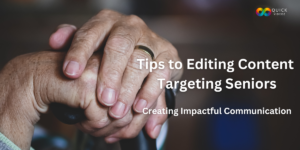
11 Key Factors While Editing Content Targeting Seniors
11 Key Factors While Editing Content Targeting Seniors Editing content requires careful attention to detail and a systematic approach to ensure clarity, coherence, and accuracy.

How to add video in your sales process. Post-Covid, the sales process in most organizations, has pretty much evolved to a digital exercise. Sales reps are pretty much talking to screens & using digital means (emails primarily) to establish connects. With everyone competing for attention using traditional methods, it’s time your shake up your approach to sales. Videoifying (adding video in) your sales process has been shown not only to increase engagement levels, better personalization, better UX, but also increase in conversions.
Here are a few tried & tested tips to add video in your sales process.
You need early adopters willing to try out something new. Convincing those sales reps to add video to the sale process will be faster than trying to convince those who need more proof before doing something new
This so you can figure out where video can help the most. Check with your sales team for insights. They may for example tell you that doing a pre-call video that covers 80% queries generally asked by clients on the first call might help the discovery conversation. This also helps the sales rep personalize the conversation.
Figure out existing sales workflows & see if you can add video to those. For example, sales reps might have some email campaign sequences that do well. Adding video to those will make it easier to embed in the workflows with less disruption & pushback.
To overcome initial reluctance from the sales rep in recording content, it might be helpful to create canned (pre-recorded) videos using stock footage & content from sales collateral – perhaps even your blogs. They can then use these to drag & drop in their email communication with clients. Once they get to see value in the video outreach, they will get confidence to now create personalized video communication as part of their sales pitch.
One concern most people have in creating videos is how they look or the background. Realistic videos are the in thing now, so more realistic the videos & the person making them, the better they work. Eventually it’s the story / message you are trying to convey that’s important. If you are able to create the person-to-person engagement, the background or how you look won’t really matter. Of course, creating a business video, disheveled & in your pajamas may not be the best option – but then you know that. Creating a playbook with a broad set of guidelines – covering areas such as how the tone of your video should be (formal / informal), what kind of clothes are appropriate, lighting guidelines (front lighting so that your entire face is well illuminated) & the call to action make it easier for the sales team to start creating videos.
Just using video for the sake of it makes no sense. Ask yourself, how does video help in creating more engagement, or leads or client education or closing sales. Decide the outcomes you want to see for each step – whether it’s awareness with a how-to-video, or creating trust or social proof with a client testimonial video. Without knowing the ‘why’ of your video strategy, the initiative is doomed to fail.
Sales cycles are long at times. To keep sales teams in play, ensure that the sales team uses video as an engagement tool that keeps the product / service top of mind for the client. Creating videos from your informative blogs & sending them over periodically to both influencers as well as decision makers keeps the sales proposal fresh while continually creating value for the client. A tip that works is having the sales rep create a brief clip introducing the takeaways from the video being shared. That personalizes & humanizes the interaction rather than sending just a boiler template email with the video attached.
Sales is pretty much all about incentives & recognition. Rolling out spiffs or programs that have (perhaps) a cash incentive on achieving some video goals have proven to be quite successful. Celebrating team members who have achieved success motivates not only the one being recognized, but also teammates.
With the advent of AI tools, it has become easier for marketers & sales reps alike to create videos. No more waiting & hassles to get a video creating. Companies like InVideo, B-Human, D-ID, Fliki, Synthesia, Vidyard & many more provide easy to use tools to create these videos. And for those who are short of time can always reach out to teams like ours (QuickVideoz), to create videos on their behalf. Not only is it super cost effective, but also faster than creating it yourself. (We had to do the plug didn’t we!).
It’s said that if you don’t measure, you don’t get a job done well. Sales reps & nowadays marketers are pretty comfortable with metrics nowadays & measuring the sales videoifying approach isn’t going to be different. The first measure is to track how many videos are being added in the sales process, are being sent out by the sales rep, and for each interaction, measure engagement – open rates, view times, click through rates, call backs, conversions based on the sales stage (close rates etc.). You can set up additional metrics to identify & track goals based on your specific sales objectives.
Video sales is a step up from plain vanilla emails or telephone calls. Especially in instances where there is more than one decision maker or even an influencer / champion that the sales rep needs to convince, video ensures that each one of them gets to hear the same message rather than playing Chinese whispers – and with a lot less effort. That ensures the crux of your communication isn’t lost between the contacts being reached out to. With an ability to personalize the video message, the sales rep can also make it seem that the message is being delivered for the viewers eyes only. This personalization has shown to increase sales conversions in multiple studies.
It’s not difficult to embed video in your sales process. With the above mentioned tried & tested tips you can start adding videos to your sales process and see the pipeline blow up.
Cha-Ching!
Recommended reading : Four Smart Habits of Building Brand Trust – and hence more sales

11 Key Factors While Editing Content Targeting Seniors Editing content requires careful attention to detail and a systematic approach to ensure clarity, coherence, and accuracy.

How To Write A Great Explainer Video Script For Seniors Learn how to craft a great explainer video script to sell senior focused products &

How To Make Videos For Social Media To Promote Your Business Alright, folks, let’s dive into the world of social media wizardry! If you’re eager